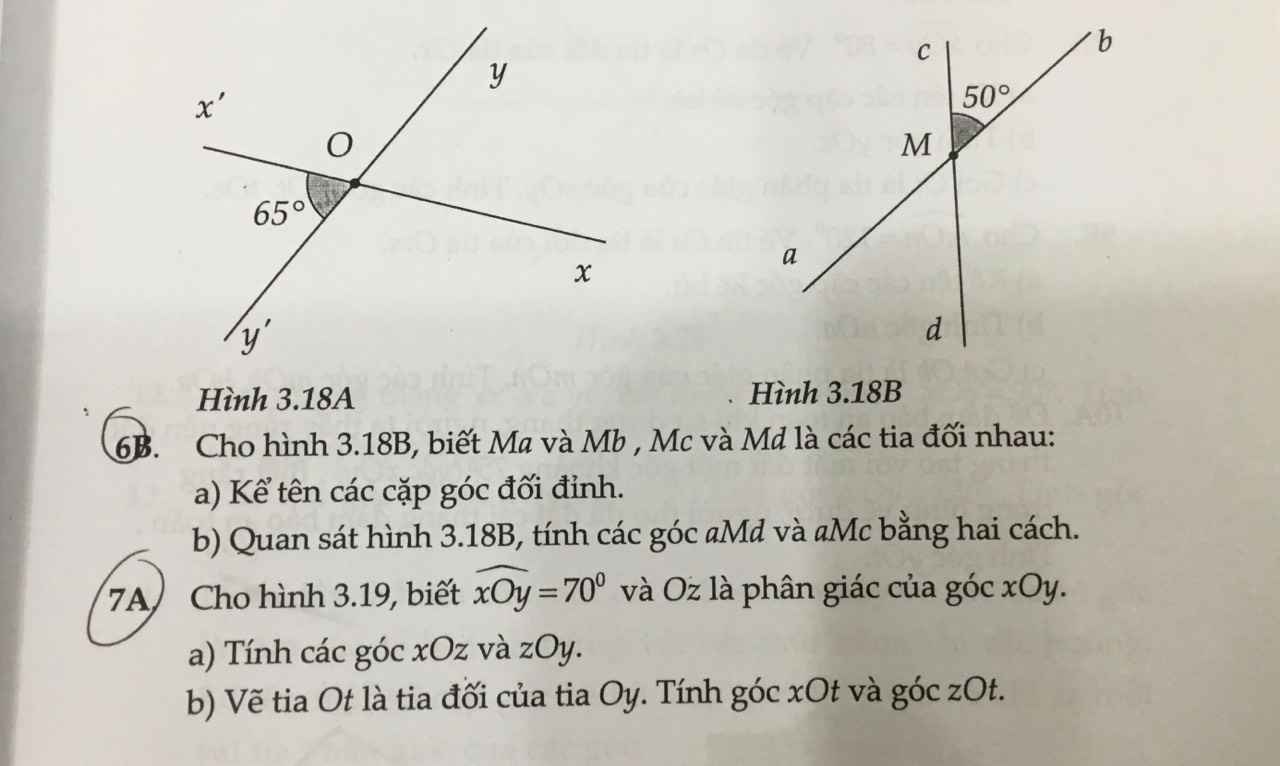Tìm một phân số bằng \(\dfrac{1}{3}\). Biết nếu cộng cả tử số và mẫu số của phân số đó với 2 ta được phân số có tử số bé hơn mẫu số là 20 đơn vị.
Hãy nhập câu hỏi của bạn vào đây, nếu là tài khoản VIP, bạn sẽ được ưu tiên trả lời.


6B:
a: Các cặp góc đối đỉnh là: \(\widehat{cMb};\widehat{aMd}\); \(\widehat{aMc};\widehat{bMd}\)
b:
Cách 1: \(\widehat{aMc}+\widehat{cMb}=180^0\)(hai góc kề bù)
=>\(\widehat{aMc}=180^0-50^0=130^0\)
Ta có: \(\widehat{aMc}+\widehat{aMd}=180^0\)(hai góc kề bù)
=>\(\widehat{aMd}=180^0-130^0=50^0\)
Cách 2:
Ta có: \(\widehat{aMd}=\widehat{cMb}\)(hai góc đối đỉnh)
mà \(\widehat{cMb}=50^0\)
nên \(\widehat{aMd}=50^0\)
Ta có: \(\widehat{aMd}+\widehat{aMc}=180^0\)(hai góc kề bù)
=>\(\widehat{aMc}+50^0=180^0\)
=>\(\widehat{aMc}=130^0\)
7A:
a: Oz là phân giác của góc xOy
=>\(\widehat{xOz}=\widehat{zOy}=\dfrac{\widehat{xOy}}{2}=35^0\)
b: Ta có: \(\widehat{xOy}+\widehat{xOt}=180^0\)(hai góc kề bù)
=>\(\widehat{xOt}+70^0=180^0\)
=>\(\widehat{xOt}=110^0\)
Ta có: \(\widehat{zOt}+\widehat{zOy}=180^0\)(hai góc kề bù)
=>\(\widehat{zOt}+35^0=180^0\)
=>\(\widehat{zOt}=145^0\)

a.
\(\Leftrightarrow\left\{{}\begin{matrix}\left(2x-3y\right)\left(2x-y\right)=0\\6x^2+7xy-5y^2=0\end{matrix}\right.\)
TH1: \(2x-3y=0\Rightarrow y=\dfrac{2}{3}x\) thay vào pt dưới
\(\Rightarrow6x^2+7x.\left(\dfrac{2}{3}x\right)-5\left(\dfrac{2}{3}x\right)^2=0\)
\(\Leftrightarrow\dfrac{76}{9}x^2=0\Rightarrow x=0\Rightarrow y=0\)
TH2: \(2x-y=0\Rightarrow y=2x\)
Tương tự ta cũng được \(x=0;y=0\)
Vậy hệ có nghiệm duy nhất \(\left(x;y\right)=\left(0;0\right)\)
b.
\(\Leftrightarrow\left\{{}\begin{matrix}13x^2-39xy+13y^2=-13\\2x^2+xy+3y^2=13\end{matrix}\right.\)
Cộng vế với vế
\(\Rightarrow15x^2-38xy+16y^2=0\)
\(\Leftrightarrow\left(x-2y\right)\left(15x-8y\right)=0\)
\(\Rightarrow\left[{}\begin{matrix}x=2y\\x=\dfrac{8}{15}y\end{matrix}\right.\)
Thay vào pt đầu:
- Với \(x=2y\Rightarrow4y^2-6y^2+y^2=-1\)
\(\Rightarrow y^2=1\Rightarrow\left[{}\begin{matrix}y=1\Rightarrow x=2\\y=-1\Rightarrow x=-2\end{matrix}\right.\)
- Với \(x=\dfrac{8}{15}y\)
\(\Rightarrow\left(\dfrac{8}{15}y\right)^2-3\left(\dfrac{8}{15}y\right).y+y^2=-1\)
\(\Leftrightarrow-\dfrac{71}{225}y^2=-1\Rightarrow y^2=\dfrac{225}{71}\)
\(\Rightarrow\left[{}\begin{matrix}y=\dfrac{15}{\sqrt{71}}\Rightarrow x=\dfrac{8}{\sqrt{71}}\\y=-\dfrac{15}{\sqrt{71}}\Rightarrow x=-\dfrac{8}{\sqrt{71}}\end{matrix}\right.\)

Gọi số cần tìm là x
Theo đề, ta có: \(\dfrac{-9}{5}< \dfrac{-7}{x}< \dfrac{-9}{6}\)
=>\(\dfrac{9}{5}>\dfrac{7}{x}>\dfrac{9}{6}\)
=>\(\dfrac{63}{35}>\dfrac{63}{9x}>\dfrac{63}{42}\)
=>35<9x<42
=>9x=36
=>x=4
Gọi mẫu số của phân số cần tìm là \(x\) ( 0 ≠ \(x\) \(\in\) Z)
\(\dfrac{-9}{5}\) < \(\dfrac{-7}{x}\) < \(\dfrac{-9}{6}\)
⇒ \(\dfrac{-9.\left(-1\right)}{5.}\) > \(\dfrac{-7.\left(-1\right)}{x}\) > \(\dfrac{-9.\left(-1\right)}{6}\) (nhân cả hai vế của bất đẳng thức với một số âm thì bất đẳng thức đổi chiều)
⇒\(\dfrac{9}{5}\) > \(\dfrac{7}{x}\) > \(\dfrac{9}{6}\)
⇒ \(\dfrac{9.7}{5.7}\) > \(\dfrac{7.9}{x.9}\) > \(\dfrac{9.7}{6.7}\)
⇒ \(\dfrac{63}{35}\) > \(\dfrac{63}{9x}\) > \(\dfrac{63}{42}\)
⇒ 35 < 9\(x\) < 42
\(\dfrac{35}{9}\) < \(x\) < \(\dfrac{42}{9}\)
3\(\dfrac{8}{9}\) < \(x\) < 4\(\dfrac{6}{9}\)
Vậy \(x=4\)

1: \(3^{x+2}+3^x=10\)
=>\(9\cdot3^x+3^x=10\)
=>\(10\cdot3^x=10\)
=>\(3^x=1\)
=>x=0
2: \(2^{x+1}-2^x=32\)
=>\(2^x\cdot2-2^x=32\)
=>\(2^x=32=2^5\)
=>x=5
3: \(4^{x+2}-4^x=60\)
=>\(4^x\cdot16-4^x=60\)
=>\(15\cdot4^x=15\cdot4\)
=>\(4^x=4\)
=>x=1
4: \(2^{x+2}-2^x=96\)
=>\(4\cdot2^x-2^x=96\)
=>\(3\cdot2^x=3\cdot32\)
=>\(2^x=32\)
=>x=5
5: \(2^{x+3}+2^x=144\)
=>\(2^x\cdot8+2^x=144\)
=>\(9\cdot2^x=9\cdot16\)
=>\(2^x=16\)
=>x=4
6: \(3^{x+3}-3^x=234\)
=>\(3^x\cdot27-3^x=234\)
=>\(26\cdot3^x=234\)
=>\(3^x=9=3^2\)
=>x=2
7:
\(5^x+5^{x+1}=750\)
=>\(5^x+5\cdot5^x=750\)
=>\(6\cdot5^x=750\)
=>\(5^x=125=5^3\)
=>x=3
8: \(2^x+2^{x+2}=320\)
=>\(2^x+2^x\cdot4=320\)
=>\(5\cdot2^x=320\)
=>\(2^x=64=2^6\)
=>x=6
9: \(5^x+5^{x+2}=650\)
=>\(5^x+5^x\cdot25=650\)
=>\(26\cdot5^x=650\)
=>\(5^x=\dfrac{650}{26}=25=5^2\)
=>x=2

a: \(x^3=64\)
=>\(x^3=4^3\)
=>x=4
b: \(x^2=2^3+3^2+4^3\)
=>\(x^2=8+9+64=64+17=81\)
mà x>0
nên \(x=\sqrt{81}=9\)
c: \(3x^2+123=231\)
=>\(3x^2=231-123=108\)
=>\(x^2=36\)
mà x>0
nên x=6
d: \(145-2x^2=136:8\)
=>\(145-2x^2=17\)
=>\(2x^2=128\)
=>\(x^2=64\)
mà x>0
nên x=8

a: \(5\cdot5^2\cdot5^4\cdot5^8=5^{1+2+4+8}=5^{15}\)
b: \(2^3\cdot2^4\cdot2^5:2^6=2^{3+4+5-6}=2^6\)
c: \(x^2\cdot x^3:x^4\cdot x^7=x^{2+3-4+7}=x^8\)
d: \(\left(7^3:7^2\right)\cdot\left(7^2\cdot7^4\right):\left(7^2\cdot7\right)\)
\(=7\cdot7^6:7^3\)
\(=7^7:7^3=7^4\)

Thể tích nước buổi sáng bơm vào là:
\(2\cdot1,6\cdot1,5\cdot80\%=3,2\cdot1,2=3,84\left(m^3\right)=3840\left(lít\right)\)
Lượng nước còn lại sau khi dùng là:
\(3840\left(1-80\%\right)=768\left(lít\right)\)
2m=20dm; 1,6m=16dm; 1,5m=15dm
Thể tích tối đa của bể là: \(20\cdot16\cdot15=300\cdot16=4800\left(lít\right)\)
Lượng nước cần bơm vào là:
4800-768=4032(lít)






Tử số ban đầu là 20:(3-1)x1=10
Mẫu số ban đầu là 10+20=30